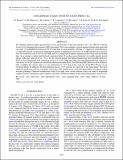Files in this item
A multiphase Suzaku study of X-rays from τ Sco
Item metadata
| dc.contributor.author | Ignace, R. | |
| dc.contributor.author | Oskinova, L. M. | |
| dc.contributor.author | Jardine, M. | |
| dc.contributor.author | Cassinelli, J. P. | |
| dc.contributor.author | Cohen, D. H. | |
| dc.contributor.author | Donati, J.-F. | |
| dc.contributor.author | Townsend, R. H. D. | |
| dc.contributor.author | ud-Doula, A. | |
| dc.date.accessioned | 2016-11-16T16:30:15Z | |
| dc.date.available | 2016-11-16T16:30:15Z | |
| dc.date.issued | 2010-10-01 | |
| dc.identifier | 24561906 | |
| dc.identifier | 7e1ed856-8653-4a92-9252-7e45d75f260f | |
| dc.identifier | 000282193600039 | |
| dc.identifier | 78149235562 | |
| dc.identifier.citation | Ignace , R , Oskinova , L M , Jardine , M , Cassinelli , J P , Cohen , D H , Donati , J-F , Townsend , R H D & ud-Doula , A 2010 , ' A multiphase Suzaku study of X-rays from τ Sco ' , Astrophysical Journal , vol. 721 , no. 2 , pp. 1412-1420 . https://doi.org/10.1088/0004-637X/721/2/1412 | en |
| dc.identifier.issn | 0004-637X | |
| dc.identifier.other | BibCode: 2010ApJ...721.1412I | |
| dc.identifier.other | ORCID: /0000-0002-1466-5236/work/57821885 | |
| dc.identifier.uri | https://hdl.handle.net/10023/9829 | |
| dc.description.abstract | We obtained relatively high signal-to-noise X-ray spectral data of the early massive star tau Sco (B0.2V) with the Suzaku X-ray Imaging Spectrometer (XIS) instrument. This source displays several unusual features that motivated our study: (1) redshifted absorption in UV P Cygni lines to approximately +250 km s-1 suggestive of infalling gas, (2) unusually hard X-ray emission requiring hot plasma at temperatures in excess of 10 MK whereas most massive stars show relatively soft X-rays at a few MK, and (3) a complex photospheric magnetic field of open and closed field lines. In an attempt to understand the hard component better, X-ray data were obtained at six roughly equally spaced phases within the same epoch of tau Sco's 41 day rotation period. The XIS instrument has three operable detectors: XIS1 is back-illuminated with sensitivity down to 0.2 keV; XIS0 and XIS2 are front-illuminated with sensitivity only down to 0.4 keV and have an overall less effective area than XIS1. The XIS0 and XIS3 detectors show relatively little variability. In contrast, there is a approximate to ≈4 sigma detection of a approximate to ≈4% drop in the count rate of the XIS1 detector at one rotational phase. In addition, all three detectors show a approximate to ≈3% increase in count rate at the same phase. The most optimistic prediction of X-ray variability allows for a 40% change in the count rate, particularly near phases where we have pointings. Observed modulations in the X-ray light curve on the rotation cycle is an order of magnitude smaller than this, which places new stringent constraints on future modeling of this interesting magnetic massive star. | |
| dc.format.extent | 9 | |
| dc.format.extent | 2663887 | |
| dc.language.iso | eng | |
| dc.relation.ispartof | Astrophysical Journal | en |
| dc.subject | Stars: early-type | en |
| dc.subject | Stars: individual: τ Sco | en |
| dc.subject | Stars: magnetic field | en |
| dc.subject | Stars: winds | en |
| dc.subject | Outflows | en |
| dc.subject | X-rays: stars | en |
| dc.subject | QB Astronomy | en |
| dc.subject | QC Physics | en |
| dc.subject.lcc | QB | en |
| dc.subject.lcc | QC | en |
| dc.title | A multiphase Suzaku study of X-rays from τ Sco | en |
| dc.type | Journal article | en |
| dc.contributor.sponsor | Science & Technology Facilities Council | en |
| dc.contributor.institution | University of St Andrews. School of Physics and Astronomy | en |
| dc.contributor.institution | University of St Andrews. University of St Andrews | en |
| dc.identifier.doi | 10.1088/0004-637X/721/2/1412 | |
| dc.description.status | Peer reviewed | en |
| dc.identifier.url | http://adsabs.harvard.edu/abs/2010ApJ...721.1412I | en |
| dc.identifier.grantnumber | ST G001987 1 | en |
This item appears in the following Collection(s)
Items in the St Andrews Research Repository are protected by copyright, with all rights reserved, unless otherwise indicated.

